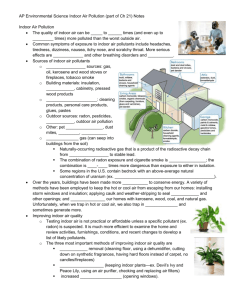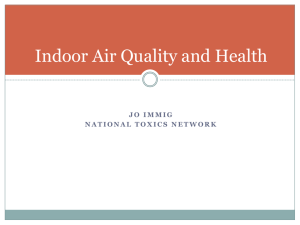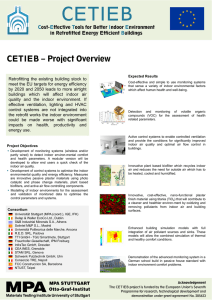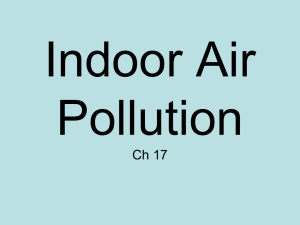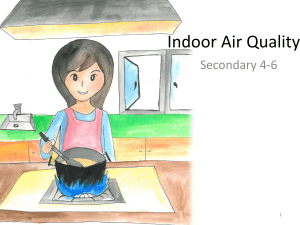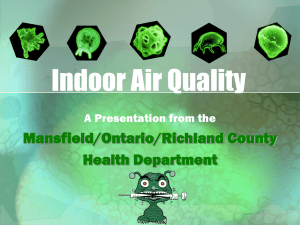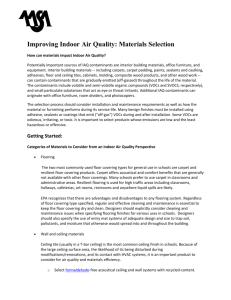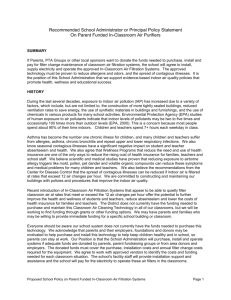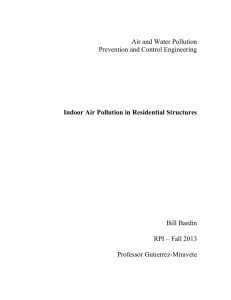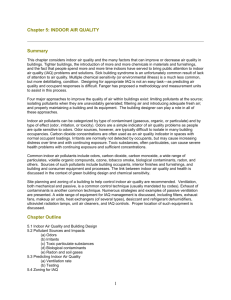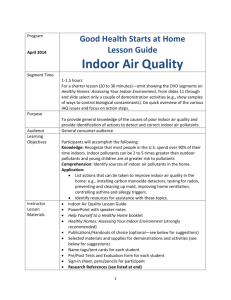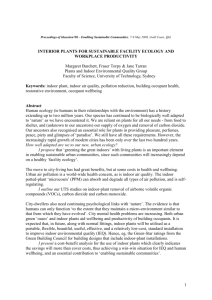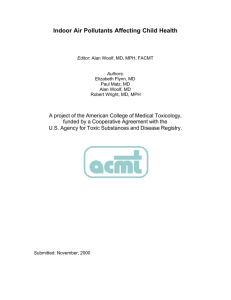Carbon Monoxide Statistics:
advertisement
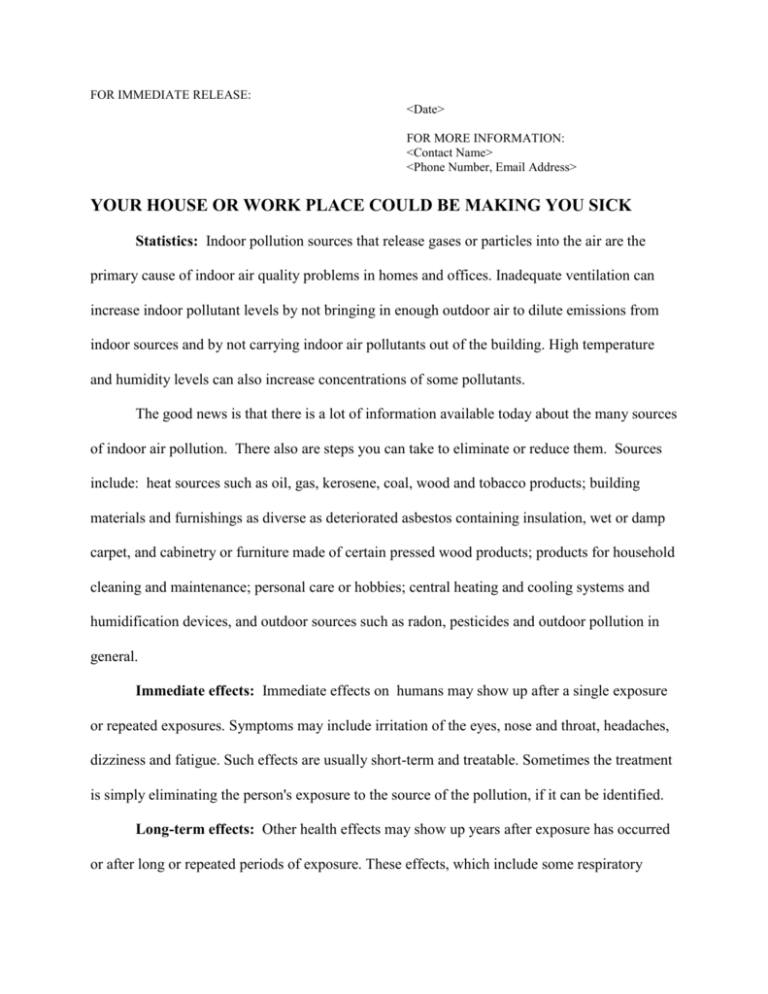
FOR IMMEDIATE RELEASE: <Date> FOR MORE INFORMATION: <Contact Name> <Phone Number, Email Address> YOUR HOUSE OR WORK PLACE COULD BE MAKING YOU SICK Statistics: Indoor pollution sources that release gases or particles into the air are the primary cause of indoor air quality problems in homes and offices. Inadequate ventilation can increase indoor pollutant levels by not bringing in enough outdoor air to dilute emissions from indoor sources and by not carrying indoor air pollutants out of the building. High temperature and humidity levels can also increase concentrations of some pollutants. The good news is that there is a lot of information available today about the many sources of indoor air pollution. There also are steps you can take to eliminate or reduce them. Sources include: heat sources such as oil, gas, kerosene, coal, wood and tobacco products; building materials and furnishings as diverse as deteriorated asbestos containing insulation, wet or damp carpet, and cabinetry or furniture made of certain pressed wood products; products for household cleaning and maintenance; personal care or hobbies; central heating and cooling systems and humidification devices, and outdoor sources such as radon, pesticides and outdoor pollution in general. Immediate effects: Immediate effects on humans may show up after a single exposure or repeated exposures. Symptoms may include irritation of the eyes, nose and throat, headaches, dizziness and fatigue. Such effects are usually short-term and treatable. Sometimes the treatment is simply eliminating the person's exposure to the source of the pollution, if it can be identified. Long-term effects: Other health effects may show up years after exposure has occurred or after long or repeated periods of exposure. These effects, which include some respiratory 2 diseases, heart disease and cancer, can be severely debilitating or fatal. It is prudent to try to improve the indoor air quality in your home even if symptoms are not noticeable. Common Sources for Indoor Air Pollution Asbestos: Asbestos is a mineral fiber that has been used commonly in a variety of building construction materials for insulation and as a fire-retardant. The EPA and CPSC have banned several asbestos products. Manufacturers have also voluntarily limited uses of asbestos. Today, asbestos is most commonly found in older homes, in pipe and furnace insulation materials, asbestos shingles, millboard, textured paints and other coating materials, and floor tiles Carbon Monoxide: Sources for carbon monoxide include un-vented kerosene and gas space heaters; leaking chimneys and furnaces; back drafting from furnaces, gas water heaters, wood stoves and fireplaces; gas stoves; generators and other gasoline powered equipment; automobile exhaust from attached garages; and tobacco smoke. Biological Pollutants: Biological contaminants include bacteria, molds and mildews, viruses, animal dander and cat saliva, house dust, mites, cockroaches and pollen. There are many sources of these pollutants. Pollens originate from plants; viruses are transmitted by people and animals; bacteria are carried by people, animals, soil and plant debris; household pets are sources of saliva and animal dander. The protein in urine from rats and mice is a potent allergen. When it dries, it can become airborne. Contaminated central air handling systems can become breeding grounds for mold, mildew, and other sources of biological contaminants and can then distribute these contaminants through the home. Formaldehyde: Sources of formaldehyde in the home include building materials, smoking, household products, and the use of un-vented, fuel-burning appliances, like gas stoves or kerosene space heaters. Formaldehyde, by itself or in combination with other chemicals, serves a number of purposes in manufactured products. For example, it is used to add permanent- 3 press qualities to clothing and draperies, as a component of glues and adhesives, and as a preservative in some paints and coating products. In homes, the most significant sources of formaldehyde are likely to be found in pressed wood products made using adhesives that contain urea-formaldehyde (UF) resins. Pressed wood products made for indoor use include: particleboard (used as sub-flooring and shelving and in cabinetry and furniture); hardwood plywood paneling (used for decorative wall covering and used in cabinets and furniture); and medium density fiberboard (used for drawer fronts, cabinets and furniture tops). Medium density fiberboard contains a higher resin-to-wood ratio than any other UF pressed wood product and is generally recognized as being the highest formaldehydeemitting pressed wood product. Pesticides: According to a recent survey, 75 percent of U.S. households used at least one pesticide product indoors during the past year. Products used most often are insecticides and disinfectants. Another study suggests that 80 percent of most people's exposure to pesticides occurs indoors and that measurable levels of up to a dozen pesticides have been found in the air inside homes. Radon: Radon is a cancer-causing, radioactive gas. You can't see radon. And you can't smell it or taste it. But it may be a problem in your home. Radon is estimated to cause many thousands of deaths each year. That's because when you breathe air containing radon, you can get lung cancer. In fact, the surgeon general has warned that radon is the second leading cause of lung cancer in the United States today. Only smoking causes more lung cancer deaths. While pollutants commonly found in indoor air are responsible for many harmful effects, there is considerable uncertainty about what concentrations or periods of exposure are necessary to produce specific health problems. People also react very differently to exposure to indoor air pollutants. Further research is needed to better understand which health effects occur after 4 exposure to the average pollutant concentrations found in homes and which occur from the higher concentrations. For more information, contact your licensed plumbing, heating and cooling contractor for an onsite assessment of your indoor air quality needs. ### <Information on your chapter goes here. > Since 1883, members of PHCC have served a vital role in safeguarding the health, safety and comfort of society and protecting the environment. The association’s contributions are being recognized in 2008 during a year-long 125th anniversary celebration, which includes National Plumbing Industry Week April 27-May 3. Go to www.phccweb.org <http://www.phccweb.org> to find a PHCC member in your area, or call (800)533-7694.

